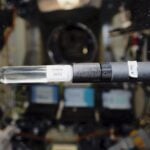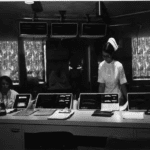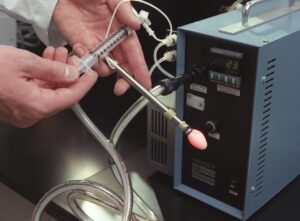Light Emitting Diodes for medical applications
Inducted In: 2000, Health, Medicine
One of NASA’s life science research goals is to better understand plant growth in microgravity. NASA found that it was difficult to use traditional plant growth light sources in space because they require considerable power and turn much of it into heat. This means that the experimental system has to have good controls to eliminate temperature variance that could affect plant growth results. The Wisconsin Center for Space Automation & Robotics proposed using light emitting diodes (LEDs) as the photon source for plant growth experiments conducted in space. This idea generated considerable discussion, as the prevailing view among experts was that LEDs could not provide the necessary wavelengths and intensities needed for photosynthesis. The Wisconsin group teamed with Quantum Devices, Inc. to develop an LED system that was successful in supporting photosynthesis.
The Wisconsin Center then produced the Astroculture3, a plant growth chamber that incorporated the LED light source and has flown on 7 shuttle missions. An ongoing medical objective is to find better ways to remove cancerous tumors. A promising mechanism for treating inoperable tumors is to use light-sensitive, tumor-treating drugs. This Photodynamic Therapy (PDT) approach allows physicians to activate the drug only in the tumor. The most common used light source to activate a tumor drug is a laser. The problem with a laser is that it is expensive, bulky, and somewhat unreliable in a surgical environment. What is needed is a small, highly reliable light source that could provide specific energies and intensities. A NASA Small Business Innovative Research award was given to Quantum Devices, Inc. and Harry Whelan, MD to develop an LED light source that could be used in a surgical environment as the photon source for PDT. As a result of over 5 years of intensive research and experimentation a functioning LED probe has been developed and has received FDA approval for use in patients who exhausted all other means of treatment.
To date the LED treatment has focused on skin cancers and brain tumors. Several successful cases have been reported. Another NASA need has led to yet another possible application for the use of LEDs. In microgravity wounds heal much more slowly. The Wisconsin team has conducted experiments that demonstrate that LEDs have help human-cell cultures grow 5 times faster than normal. These results have led to a research program that is testing LEDs capability to increase wound healing. If the experimental results are promising, human clinical trials will follow. The outcome could be a new medical instrument that can used on long duration space flights to treat astronaut’s wounds as well as having a new technology on Earth to treat burns, sport’s injuries, etc.
Related Technologies

Bubble Detector
Inducted In: Featured, Health, Public Safety
Canada’s Bubble Technology Industries (BTI) created the Bubble Detector to detect and record levels of neutron radiation exposure to humans. The detector is a small vial about the size of your thumb. It is small enough and portable enough to…

Apollo 70 Cardiac Care Monitoring System
Inducted In: Featured, Health, Medicine
Founded in 1958, Spacelabs Healthcare approached NASA with their concept of a real-time system for monitoring astronauts’ vital signs while in orbit, including a telemetry system to simultaneously transmit the data back to Earth. From 1962 to 1967, Spacelabs was…

Programmable Implantable Medication System
A family of biomedical implantable devices have been developed over the past decade which are based on a wide array of space technologies, including battery advances, miniaturized circuitry, digital telemetry, and electronic sensing systems. The initial device was the rechargeable…

